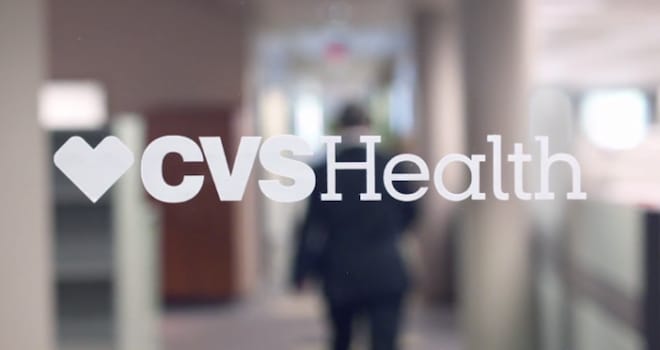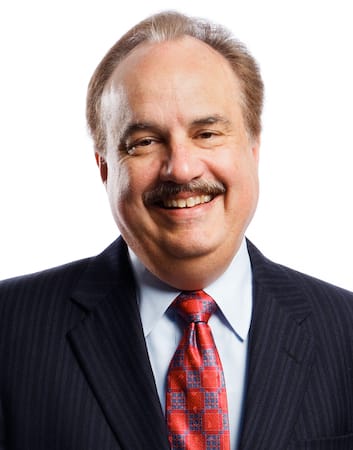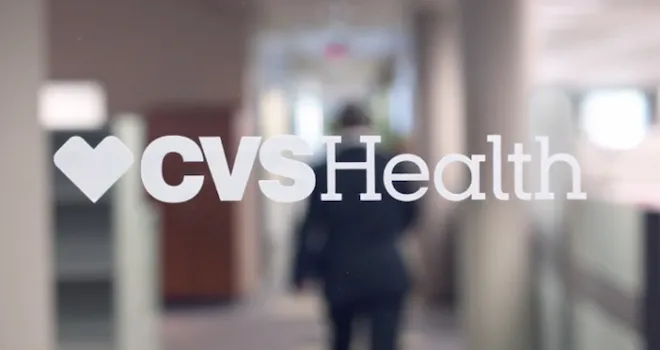
WOONSOCKET, R.I. — Driven by growth in its pharmacy benefit management unit, and overcoming softness in its retail business, CVS Health posted increased sales and beat Wall Street’s earnings forecast for its 2017 fourth quarter and fiscal year.
CVS said Thursday that for the fourth quarter ended Dec. 31, total revenue rose 5.3% to $48.39 billion from $45.97 billion a year earlier. In the full fiscal year, sales came in at $184.77 billion, up 4.1% from $177.53 billion a year ago.
Sales in the retail/long-term care segment edged up 0.3% to $20.91 billion in the fourth quarter from $20.84 billion in the prior-year period.
CVS attributed the uptick mainly to a 2.5% gain in same-store prescriptions (on a 30-day equivalent basis) and branded drug inflation, partially offset by an increased generic drug dispensing rate and continued reimbursement pressure. The company said restricted networks that exclude CVS Pharmacy had a negative impact of 320 basis points on same-store prescription count in the quarter.
Retail/LTC sales for the year fell 2.1% to $79.4 billion from $81.1 billion in fiscal 2016. Same-store prescription volumes was up 0.4% on a 30-day equivalent basis for 2017. Restricted networks excluding CVS Pharmacy had a negative impact of 420 basis points on same-store script count in 2017.
On a comparable-store basis, sales inched up 0.1% in the fourth quarter, reflecting a 0.4% gain in the pharmacy and a 0.7% decrease in the front end. Front-end same-store sales got a lift of 80 basis points from seasonal cough/cold sales, CVS said, but were negatively impacted by softer customer traffic and efforts to rationalize promotional strategies, partially offset by growth in basket size. For the year, same-store sales were down 2.6%, including declines of 2.6% in both the front end and the pharmacy.
CVS said comparable-pharmacy sales were negatively impacted by 340 and 390 basis points from introductions of new generic drugs in the fourth quarter and full year, respectively.

Larry Merlo
In the pharmacy services segment, revenue climbed 9.3% to $34.15 billion in the fourth quarter from$31.26 billion a year earlier. The gain stems primarily from growth in pharmacy network and specialty pharmacy volume as well as brand inflation, partially offset by price compression and higher generic dispensing, according to CVS. Pharmacy network claims processed in the quarter rose 8.2%, on a 30-day equivalent basis, to 389.7 million, fueled mainly by an increase in net new business.
Pharmacy services sales for 2017 were up 8.9% to $130.6 billion from $120.0 billion in 2016.
CVS said that, for the fourth quarter, the generic dispensing rate grew by 80 basis points year over year to 86.9% in the pharmacy services segment and by 160 basis points to 86.8% in the retail/LTC segment.
During 2017, CVS opened 175 retail stores, relocated 30 stores and closed 81 stores. As of Dec. 31, the company operated 9,803 retail locations, including pharmacies in Target stores, in 49 states, the District of Columbia, Puerto Rico and Brazil.
Consolidated operating profit for the fourth quarter increased 3.6% to $3.1 billion. For the full year, operating profit was down 8.2% to $9.5 billion. CVS said the decline was primarily driven by the restricted networks that exclude CVS Pharmacy and continued pricing and reimbursement pressure in both of its business segments.
“In 2017, we delivered on the four-point plan we set in place to return to more robust levels of growth,” CVS Health president and chief executive officer Larry Merlo said in a statement. “Our position in the evolving health care landscape is stronger than ever before, and we remain confident in our model and in our ability to make health care more affordable, more accessible and more effective.”
On the earnings side, CVS reported net income of $3.29 billion, or $3.22 per diluted share (GAAP), for the 2017 fourth quarter, compared with $1.71 billion, or $1.59 per diluted share, a year ago. For the 2017 fiscal year, net earnings came in at $6.62 billion, or $6.45 per diluted share, up from $5.32 billion, or $4.91 per diluted share, in fiscal 2016.
CVS said the increase in both periods reflects an the income tax benefit of $1.5 billion from the Tax Cuts & Jobs Act (TCJA). Among other changes to tax laws, the TCJA lowered the corporate income tax rate from 35% to 21%, which reduced the company’s net deferred income tax liabilities. That was partially offset by changes in operating profit. In addition, net income for the quarter and year includes $56 million of bridge financing costs from the proposed acquisition of Aetna Inc., which is included in interest expense. Net income for the year also includes $187 million in losses on settlements of defined benefit pension plans, while net earnings for the prior year reflect a $643 million loss on early extinguishment of debt, CVS noted.
Adjusted earnings per share (EPS) for the 2017 fourth quarter was $1.92, up from $1.71 a year ago, CVS reported. Analysts, on average, had projected adjusted EPS for the quarter at $1.89, with estimates ranging from a low of $1.87 to a high of $1.92, according to Thomson Reuters.
For the year, CVS said adjusted EPS was $5.90, up from $5.84 in 2016. Analysts’ consensus adjusted EPS forecast for 2017 was $5.88, with projections running from a low of $5.84 to a high of $5.91.
“We enter 2018 with the foundation to propel us to win across all of our businesses. I’m very pleased with the strong PBM selling season we had, with gross client wins of $6.2 billion, and our retail collaborations are expected to drive solid performance in our pharmacies,” Merlo stated. “I’m also pleased with the progress we’ve made in providing superior value for patients, payors, and providers, and we look forward to the opportunities ahead to improve upon our progress.”
CVS said it has revised its 2018 guidance to reflect the effects of the tax reform achieved through the TCJA. Besides debt reduction, the company is allocating part of the benefits to additional investments in employees, data analytics, care management solutions and service offering enhancements, some of which will be capitalized. The impact to CVS 2018 consolidated operating profit is projected to be at least $275 million.
With these investments, CVS changed its adjusted operating profit growth forecast of 1% to 4% for 2018 to range of down 1.5% to up 1.5%. The company projects adjusted operating profit growth of 0.5% to 4.5% for the first quarter.
“With $1.2 billion in cash benefits from the Tax Cuts and Jobs Act, we will be able to make strategic investments in our business in 2018 to stimulate greater growth over the longer term, and our updated guidance reflects this,” according to David Denton, executive vice president and chief financial officer. “These investments will accelerate our ability to continue to improve health outcomes and lower costs for patients. Additionally, we will spend at least half of the benefits on debt reduction as we look to lower our leverage ratio.”
In its earnings report, CVS didn’t provide adjusted EPS guidance for 2018. Analysts, on average, project adjusted EPS of $6.43 for the full year, with estimates ranging from a low of $6.10 to a high of $7.17, according to Thomson Reuters.









